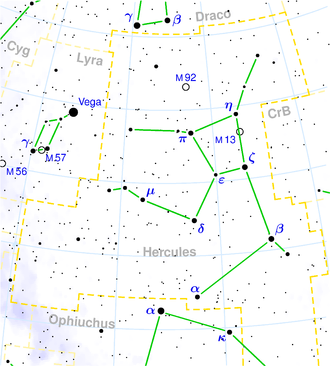NGC 6173
| Galaxy NGC 6173 |
|
|---|---|

|
|
| SDSS recording | |
| AladinLite | |
| Constellation | Hercules |
|
Position equinox : J2000.0 , epoch : J2000.0 |
|
| Right ascension | 16 h 29 m 44.9 s |
| declination | + 40 ° 48 ′ 42 ″ |
| Appearance | |
| Morphological type | cD; E / AGN |
| Brightness (visual) | 12.2 mag |
| Brightness (B-band) | 13.2 mag |
| Angular expansion | 1.9 ′ × 1.4 ′ |
| Position angle | 140 ° |
| Surface brightness | 13.3 mag / arcmin² |
| Physical data | |
| Affiliation | Abell 2197 |
| Redshift | 0.029300 +/- 0.000050 |
| Radial velocity | 8784 +/- 15 km / s |
|
Stroke distance v rad / H 0 |
(400 ± 28) x 10 6 ly (122.5 ± 8.6) Mpc |
| history | |
| discovery | Wilhelm Herschel |
| Discovery date | March 18, 1787 |
| Catalog names | |
| NGC 6173 • UGC 10421 • PGC 58348 • CGCG 224-049 • MCG + 07-34-83 • 2MASX J16294485 + 4048421 • GC 4212 • H III 640 • h 1962 • LDCE 1190 NED020 | |
NGC 6173 is a 12.2 likes bright elliptical galaxy with an active galactic nucleus from Hubble type E3 in the constellation Hercules . It is estimated to be 400 million light years from the Milky Way and about 225,000 ly in diameter.
The object was discovered on March 18, 1787 by Wilhelm Herschel with an 18.7-inch reflector telescope, who described it as "vF, vS".
